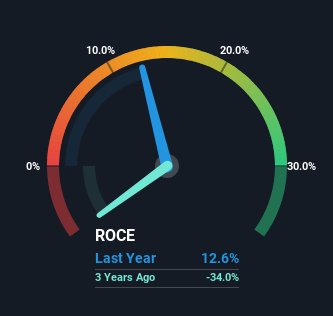What financial metrics can indicate to us that a company is maturing or even in decline? Typically, we'll see the trend of both return on capital employed (ROCE) declining and this usually coincides with a decreasing amount of capital employed. This indicates the company is producing less profit from its investments and its total assets are decreasing. And from a first read, things don't look too good at FRIWO (ETR:CEA), so let's see why.
Understanding Return On Capital Employed (ROCE)
If you haven't worked with ROCE before, it measures the 'return' (pre-tax profit) a company generates from capital employed in its business. The formula for this calculation on FRIWO is:
Return on Capital Employed = Earnings Before Interest and Tax (EBIT) ÷ (Total Assets - Current Liabilities)
0.13 = €3.3m ÷ (€91m - €65m) (Based on the trailing twelve months to June 2023).
So, FRIWO has an ROCE of 13%. That's a pretty standard return and it's in line with the industry average of 13%.
See our latest analysis for FRIWO

Historical performance is a great place to start when researching a stock so above you can see the gauge for FRIWO's ROCE against it's prior returns. If you're interested in investigating FRIWO's past further, check out this free graph covering FRIWO's past earnings, revenue and cash flow.
So How Is FRIWO's ROCE Trending?
We are a bit worried about the trend of returns on capital at FRIWO. To be more specific, the ROCE was 21% five years ago, but since then it has dropped noticeably. And on the capital employed front, the business is utilizing roughly the same amount of capital as it was back then. Companies that exhibit these attributes tend to not be shrinking, but they can be mature and facing pressure on their margins from competition. If these trends continue, we wouldn't expect FRIWO to turn into a multi-bagger.
While on the subject, we noticed that the ratio of current liabilities to total assets has risen to 71%, which has impacted the ROCE. Without this increase, it's likely that ROCE would be even lower than 13%. And with current liabilities at these levels, suppliers or short-term creditors are effectively funding a large part of the business, which can introduce some risks.
The Bottom Line On FRIWO's ROCE
All in all, the lower returns from the same amount of capital employed aren't exactly signs of a compounding machine. Investors must expect better things on the horizon though because the stock has risen 10% in the last five years. Regardless, we don't like the trends as they are and if they persist, we think you might find better investments elsewhere.
On a final note, we found 5 warning signs for FRIWO (3 don't sit too well with us) you should be aware of.
For those who like to invest in solid companies, check out this free list of companies with solid balance sheets and high returns on equity.
New: AI Stock Screener & Alerts
Our new AI Stock Screener scans the market every day to uncover opportunities.
• Dividend Powerhouses (3%+ Yield)
• Undervalued Small Caps with Insider Buying
• High growth Tech and AI Companies
Or build your own from over 50 metrics.
Have feedback on this article? Concerned about the content? Get in touch with us directly. Alternatively, email editorial-team (at) simplywallst.com.
This article by Simply Wall St is general in nature. We provide commentary based on historical data and analyst forecasts only using an unbiased methodology and our articles are not intended to be financial advice. It does not constitute a recommendation to buy or sell any stock, and does not take account of your objectives, or your financial situation. We aim to bring you long-term focused analysis driven by fundamental data. Note that our analysis may not factor in the latest price-sensitive company announcements or qualitative material. Simply Wall St has no position in any stocks mentioned.
About XTRA:CEA
FRIWO
Develops, manufactures, and sells power supplies units and drive solutions in Germany, Europe, Asia, and internationally.
Excellent balance sheet and good value.
Market Insights
Community Narratives




